By Pauline Weston Thomas for Fashion-Era.com
King Charles I Costume - 1625-1649
English Costume History by Dion Clayton Calthrop
- A MAN OF THE TIME OF CHARLES I -1625-1649
- A WOMAN OF THE TIME OF CHARLES I - 1625-1649
- ENGRAVINGS BY HOLLAR
This late Jacobean costume history information consists of Pages 341-355 of the chapter on the lower mid 17th century dress in the 24 YEAR REIGN era of Charles the First 1625 - 1649 and taken from English Costume by Dion Clayton Calthrop.
The 36 page section consists of a text copy of the book ENGLISH COSTUME PAINTED & DESCRIBED BY DION CLAYTON CALTHROP. Visuals, drawings and painted fashion plates in the book have a charm of their own and are shown amid the text. The book covers both male and female dress history of over 700 years spanning the era 1066-1830.

This page is about dress in the reign of the Stuart King, Charles I 1625-1649.
For the Introduction to this book see this introduction written by Dion Clayton Calthrop. I have adjusted the images so they can be used for colouring worksheets where pupils add some costume/society facts.
My comments are in italics.
CHARLES THE FIRST Reigned twenty-four years: 1625-1649.
Born 1600 Married 1625, Henrietta of France.
THE MEN
This surely is the age of elegance, if one may trust such an elegant and graceful mind as had Vandyck. In all the wonderful gallery of portraits he has left, these silvery graceful people pose in garments of ease.
The main thing that I must do is to show how, gradually, the stiff Jacobean dress became unfrozen from its clutch upon the human form, how whalebones in men's jackets melted away, breeches no longer swelled themselves with rags and bran, collars fell down, and shirts lounged through great open spaces in the sleeves.
It was the time of an immaculate carelessness; the hair was free, or seemed free, to droop in languid tresses on men's shoulders, curl at pretty will on men's foreheads. Shirts were left open at the neck, breeches were loosed at the knee.
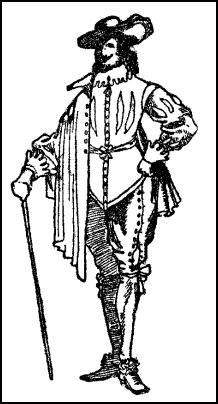
Do I revile the time if I say that the men had an air, a certain supercilious air, of being dukes disguised as art students?
We know, all of us, the Vandyck beard, the Carolean moustache brushed away from the lips; we know Lord Pembroke's tousled - carefully tousled - hair; Kiligrew's elegant locks.
The Pointed Vandyck Collar
From the head to the neck is but a step - a sad step in this reign - and here we find our friend the ruff utterly tamed; 'pickadillies, now out of request,' writes one, tamed into the falling band, the Vandyck collar, which form of neck-dress has never left the necks and shoulders of our modern youthful prodigies; indeed, at one time, no youthful genius dare be without one.

The variations of this collar are too well known; of such lace as edged them and of the manner of their tying, it would waste time to tell, except that in some instances the strings are secured by a ring.
The Doublet
 Such a change has come over the doublet as to make it hardly the same garment; the little slashes have become two or three wide cuts, the sleeves are wide and loose with, as a rule, one big opening on the inside of the arm, with this opening embroidered round.
Such a change has come over the doublet as to make it hardly the same garment; the little slashes have become two or three wide cuts, the sleeves are wide and loose with, as a rule, one big opening on the inside of the arm, with this opening embroidered round.
The Cuffs
The cuffs are like little collars, turned back with point-lace edges.
The actual cut of the doublet has not altered a great deal, the ordinary run of doublet has the pointed front, it is tied round the waist with a little narrow sash; but there has arrived a new jacket, cut round, left open from the middle of the breast, sometimes cut so short as to show the shirt below bulged out over the breeches. Sometimes you will see one of these new short jackets with a slit in the back, and under this the man will be wearing the round trunks of his father's time.
The Breeches

The breeches are mostly in two classes - the long breeches the shape of bellows, tied at the knee with a number of points or a bunch of coloured ribbons; or the breeches cut the same width all the way down, loose at the knee and there ornamented with a row of points (ribbons tied in bows with tags on them).
Knee Ribbon Ornamentation
A new method of ornamentation was this notion of coloured ribbons in bunches, on the breeches, in front, at the sides, at the knees - almost anywhere - and also upon the coats.
Silk Cloaks
For some time the older fashioned short round cape or cloak prevailed, but later, large silk cloaks used as wraps thrown across the shoulders were used as well. The other cloaks had straps, like the modern golf cape, by which the cloak might be allowed to fall from the shoulders.
Boots
A custom arrived of wearing boots more frequently, and there was the tall, square-toed, high-heeled boot, fitting up the leg to just below the knee, without a turnover; the stiff, thick leather, blacking boot with broad, stiff tops, also not turned back; and there was also the result of the extraordinary melting, crumpled dismissal of all previous stiffness, whereby the old tall boot drooped down until it turned over and fell into a wide cup, all creases and wrinkles, nearly over the foot, while across the instep was a wide, shaped flap of leather.
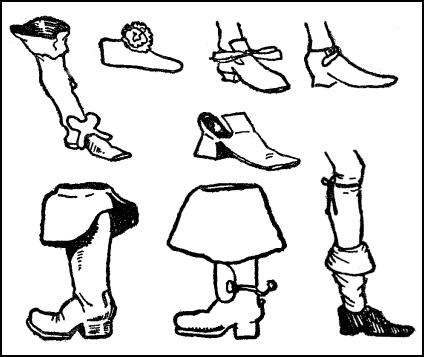
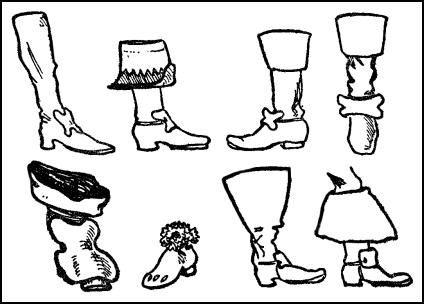
This last falling boot-top was turned in all manner of ways by those who cared to give thought to it.
The insides of the tops of these boots were lined with lace or silk, and the dandy turned them down to give full show to the lining - this turning of broad tops was such an inconvenience that he was forced to use a straddled walk when he wore his boots thus.

A MAN OF THE TIME OF CHARLES I -1625-1649
He has wrapped his blue cloak over his arm, a usual method of carrying the cloak. He is simply dressed, without bunches of ribbons or points.
Canes were carried with gold, silver, or bone heads, and were ornamented further by bunches of ribbon.
Coming again to the head, we find ribbon also in use to tie up locks of hair; delicate shades of ribbon belonging to some fair lady were used to tie up locks to show delicate shades of love. Some men wore two long love-locks on either side of the face, others wore two elaborately-curled locks on one side only.
The hats, as the drawings will show, are broad in the brim and of an average height in the crown, but a dandy, here and there, wore a hat with next to no brim and a high crown. Most hats were feathered.
Beech Wood Washing Tally System For Laundry
There is a washing tally in existence of this time belonging, I think, to the Duke of Rutland, which is very interesting.
It is made of beech-wood covered with linen, and is divided into fifteen squares. In the centre of each square there is a circle cut, and in the circle are numbers.
Over the number is a plate with a pin for pivot in the centre, a handle to turn, and a hole to expose a number. Above each circle are the names of the articles in this order:
| Ruffs. | Bandes. | Cuffes. | Handkercher. | Cappes. |
| Shirtes. | Halfshirts. | Boote Hose. | Topps. | Sockes. |
| Sheetes. | Pillowberes. | Table Clothes. | Napkins. | Towells. |
Topps are linen boot-frills, and halfshirts are stomachers.
Black
There remains little to be said except that black was a favourite dress for men, also light blue and cream-coloured satin.
Paste Jewels
Bristol paste diamonds were in great demand, and turquoise rings were very fashionable.
For the rest, Vandyck's pictures are available to most people, or good reproductions of them, and those, with a knowledge of how such dress came into being, are all that can be needed.
THE WOMEN
A WOMAN OF THE TIME OF CHARLES I - 1625-1649
Notice the broad collar and deep cuffs. The dress is simple but rich. The bodice is laced with the same colour as the narrow sash. The hair is arranged in a series of elaborate curls over the forehead.
Black Face Patches
There is one new thing you must be prepared to meet in this reign, and that will best be described by quoting the title of a book written at this time: 'A Wonder of Wonders, or a Metamorphosis of Fair Faces into Foul Visages; an invective against black-spotted faces'.
By this, you may see at once that every humour was let loose in the shapes of stars, and moons, crowns, slashes, lozenges, and even a coach and horses, cut in black silk, ready to be gummed to the faces of the fair.
Knowing from other histories of such fads that the germ of the matter lies in a royal indisposition, we look in vain for the conceited history of the Princess and the Pimple, but no doubt some more earnest enquirer after truth will hit upon the story - this toy tragedy of the dressing-table.
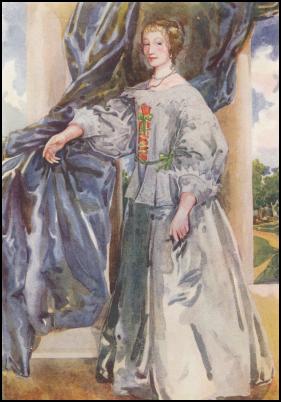
Hollar's Ornatus Muliebris Anglicanus
Wenceslas Hollar Engravings of English Women's Dress of the 17th Century
For the dress we can do no better than look at the 'Ornatus Muliebris Anglicanus,' that wonderfully careful compilation by Hollar of all the dresses in every class of society.
It is interesting to see how the Jacobean costume lost, by degrees, its formal stiffness, and first fardingale (farthingale) and then ruff vanished.
Jacobean Ladies Hairstyles
Early in the reign the high-dressed hair was abandoned, and to take its place the hair was dressed so that it was gathered up by the ears, left parted on the crown, and twisted at the back to hold a plume or feather. Time went on, and hair-dressing again altered; the hair was now taken in four parts: first the hair was drawn well back off the forehead, then the two side divisions were curled neatly and dressed to fall over the ears, the fourth group of hair was neatly twisted and so made into a small knot holding the front hair in its place. Later on came the fringe of small curls, as in the portrait of Queen Henrietta at Windsor by Vandyck.
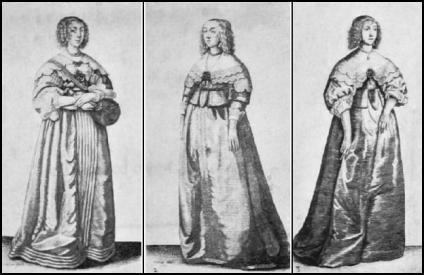

The Rebatoe - A Starched Lace High Collar
We see at first that while the ruff, or rather the rebatoe - that starched lace high collar - remained, the fardingale having disappeared, left, for the upper gown, an enormous quantity of waste loose material that had previously been stretched over the fardingale and parted in front to show the satin petticoat.

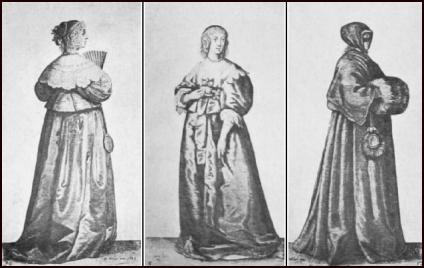
The Wide Loose Gown & Petticoat
From this there sprung, firstly, a wide, loose gown, open all the way down and tied about the middle with a narrow sash, the opening showing the boned bodice of the under-dress with its pointed protruding stomacher, the woman's fashion having retained the form of the man's jerkin. Below this showed the satin petticoat with its centre strip or band of embroidery, and the wide border of the same. In many cases the long hanging sleeves were kept.
A WOMAN OF THE TIME OF CHARLES I - 1625-1649
Notice the broad collar and deep cuffs. The dress is simple but rich. The bodice is laced with the same colour as the narrow sash. The hair is arranged in a series of elaborate curls over the forehead.
The Disappearing Ruff
Then there came the fall of the rebatoe and the decline of the protruding figure, and with this the notion of tying back the full upper skirt to show more plainly the satin petticoat, which was now losing the centre band of ornament and the border.

With this revolution in dress the disappearing ruff became at first much lower and then finally vanished, and a lace collar, falling over the shoulders, took its place.
New Collar Fashion
This gave rise to two distinct fashions in collars, the one as I have described, the other a collar from the neck, like a large edition of the man's collar of that time. This collar came over the shoulders and in two points over the breast, sometimes completely hiding the upper part of the dress.
The stiff-boned bodice gave place to one more easily cut, shorter, with, in place of the long point, a series of long strips, each strip ornamented round the hem.
The Sleeves
At this time the sleeves, different from the old-fashioned tight sleeves, were very full indeed, and the sleeve of the loose over-gown was made wider in proportion, and was tied across the under-sleeve above the elbow by a knot of ribbons, the whole ending in a deep cuff of lace. Then the over-gown disappeared, the bodice became a short jacket laced in front, openly, so as to show the sleeveless bodice of the same material and colour as the petticoat; the sleeves were not made so wide, and they were cut to come just below the elbow, leaving the wrists and forearm bare.
Dutch Jackets
In winter a lady often wore one of those loose Dutch jackets, round and full, with sleeves just long enough to cover the under-sleeves, the whole lined and edged with fur; or she might wear a short circular fur-lined cape with a small turned-over collar. In summer the little jacket was often discarded, and the dress was cut very simply but very low in the bust, and they wore those voluminous silk wraps in common with the men.
Sashes
The little sashes were very much worn, and ornaments of knots of ribbon or points (that is, a ribbon with a metal tag at either end) were universal.
Short Sleeves
The change of fashion to short full sleeves gave rise to the turned back cuff of the same material as the sleeve, and some costumes show this short jacket with its short sleeves with cuffs, while under it shows the dress with tight sleeves reaching to the wrists where were linen or lace cuffs, a combination of two fashions.
The Fan Or Muff
Part of the lady's equipment now was a big feather fan, and a big fur muff for winter; also the fashion of wearing long gloves to reach to the elbow came in with the advent of short sleeves.
Naturally enough there was every variety of evolution from the old fashion to the new, as the tight sleeves did not, of course, become immediately wide and loose, but by some common movement, so curious in the history of such revolutions, the sleeve grew and grew from puffs at the elbow to wide cuffs, to wide shoulders, until the entire sleeve became swollen out of all proportion, and the last little pieces of tightness were removed.
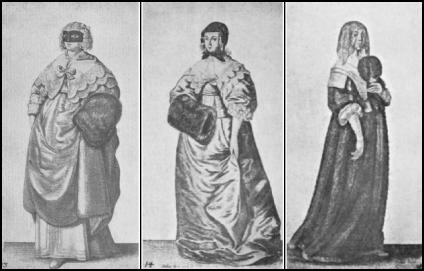
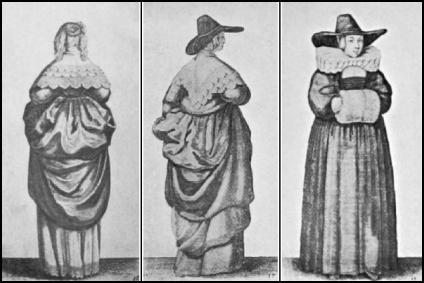
Cuffs, Lacing & Looped Skirts
The form of dress with cuffs to the jackets, lacing, sashes, bunches of ribbon, and looped up skirts, lasted for a great number of years. It was started by the death of the fardingale, and it lived into the age of hoops.
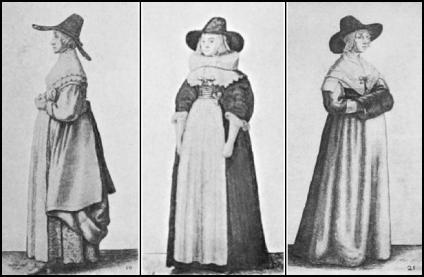
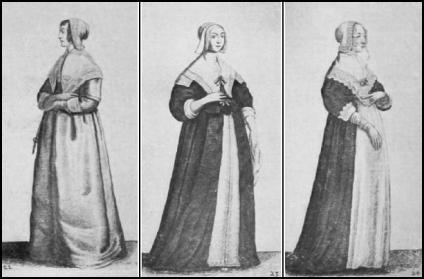
Shoes Roses
These ladies wore shoe-roses upon their shoes, and these bunches of ribbon, very artificially made up, cost sometimes as much as from three to thirty pounds a pair, these very expensive roses being ornamented with jewels. From these we derive the saying, 'Roses worth a family'.
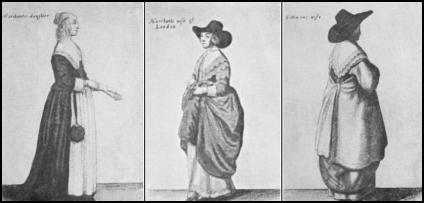
Country Women's Homespun Petticoats Or Plackets
In the country the women wore red, gray, and black cloth homespun, and for riding they put on safeguards or outer petticoats. The wide-brimmed beaver hat was in general wear, and a lady riding in the country would wear such a hat or a hood and a cloak and soft top boots.
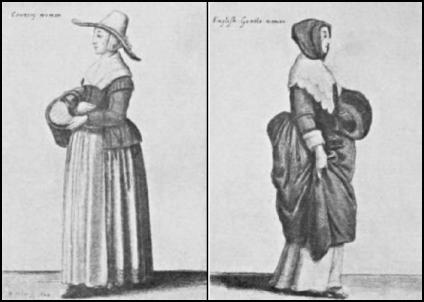
Women's petticoats were called plackets as well as petticoats.
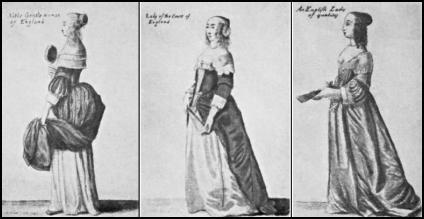
Loose Locks, Wigs and Periwigs
With the careless air that was then adopted by everybody, which was to grow yet more carefully careless in the reign of Charles II, the hair was a matter which must have undivided attention, and centuries of tight dressing had not improved many heads, so that when the loose love-locks and the dainty tendrils became the fashion, many good ladies and gentlemen had recourse to the wigmaker.
From this time until but an hundred years ago, from the periwig bought for Sexton, the fool of Henry VIII, down to the scratches and bobs of one's grandfather's youth, the wigmaker lived and prospered. To-day, more secretly yet more surely, does the maker of transformations live and prosper, but in the days when to be wigless was to be undressed the perruquier was a very great person.
This was the day, then, of satins, loosened hair, elbow sleeves, and little forehead curls. The stiffness of the older times will pass away, but it had left its clutch still on these ladies; how far it vanished, how entirely it left costume, will be seen in the next royal reign, when Nell Gwynne was favourite and Sir Peter Lely painted her.
Drawings by Wenceslaus Hollar, circa 1645
ENGRAVINGS BY HOLLAR
These excellent drawings by Hollar need no explanation. They are included in this book because of their great value as accurate contemporary drawings of costume.
CHARLES THE FIRST
Reigned twenty-four years: 1625-1649.
Born 1600 Married 1625, Henrietta of France.
- A MAN OF THE TIME OF CHARLES I -1625-1649
- A WOMAN OF THE TIME OF CHARLES I - 1625-1649
- ENGRAVINGS BY HOLLAR
This late Jacobean costume history information consists of Pages 341-355 of the chapter on the lower mid 17th century dress in the 24 YEAR REIGN era of Charles the First 1625 - 1649 and taken from English Costume by Dion Clayton Calthrop.
The 36 page section consists of a text copy of the book ENGLISH COSTUME PAINTED & DESCRIBED BY DION CLAYTON CALTHROP. Visuals, drawings and painted fashion plates in the book have a charm of their own and are shown amid the text. The book covers both male and female dress history of over 700 years spanning the era 1066-1830.
This page is about dress in the reign of the Stuart King, Charles I 1625-1649.
For the Introduction to this book see this introduction written by Dion Clayton Calthrop. I have adjusted the images so they can be used for colouring worksheets where pupils add some costume/society facts.
My comments are in italics.
You have been reading English Costume History at www.Fashion-Era.com © from the chapter Stuart King, Charles I 1625-1649 the beheaded king, from Dion Clayton Calthrop's book English Costume.
Page Added 16 August 2010. Ref:-808.